This is an old revision of this page, as edited by Mathsci (talk | contribs) at 11:39, 24 March 2013 (Undid revision 546704709 by Colleabois (talk)). The present address (URL) is a permanent link to this revision, which may differ significantly from the current revision.
Revision as of 11:39, 24 March 2013 by Mathsci (talk | contribs) (Undid revision 546704709 by Colleabois (talk))(diff) ← Previous revision | Latest revision (diff) | Newer revision → (diff)| This article needs additional citations for verification. Please help improve this article by adding citations to reliable sources. Unsourced material may be challenged and removed. Find sources: "European cuisine" – news · newspapers · books · scholar · JSTOR (June 2011) (Learn how and when to remove this message) |


European cuisine, or alternatively Western cuisine, is a generalised term collectively referring to the cuisines of Europe and other Western countries. European cuisine or Western cuisine includes that of Europe including (depending on the definition) that of Russia, as well as non-indigenous cuisines of North America, Australasia, Oceania, and Latin America, which derive substantial influence from European settlers in those regions. The term is used by East Asians to contrast with Asian styles of cooking. (This is analogous to Westerners referring collectively to the cuisines of East Asian countries as Asian cuisine.) When used by Westerners, the term may sometimes refer more specifically to cuisine in Europe or continental; in this context, a synonym is Continental cuisine, especially in British English.


The cuisines of Western countries are diverse by themselves, although there are common characteristics that distinguish Western cooking from cuisines of Asian countries and others. Compared with traditional cooking of Asian countries, for example, meat is more prominent and substantial in serving-size. Steak in particular is a common dish across the West. Similarly to some Asian cuisines, Western cuisines also put substantial emphasis on sauces as condiments, seasonings, or accompaniments (in part due to the difficulty of seasonings penetrating the often larger pieces of meat used in Western cooking). Many dairy products are utilised in the cooking process, except in nouvelle cuisine. Wheat-flour bread has long been the most common source of starch in this cuisine, along with pasta, dumplings and pastries, although the potato has become a major starch plant in the diet of Europeans and their diaspora since the European colonisation of the Americas. Maize is much less common in most European diets than it is in the Americas; however corn meal, or polenta, is a major part of the cuisine of Italy and the Balkans.
Central and Eastern European cuisines
See also: Eastern European cuisine Armenian cuisine
Armenian cuisine Azerbaijani cuisine
Azerbaijani cuisine Belarusian cuisine
Belarusian cuisine Bulgarian cuisine
Bulgarian cuisine Czech cuisine
Czech cuisine Georgian cuisine
Georgian cuisine Hungarian cuisine
Hungarian cuisine Moldovan cuisine
Moldovan cuisine Polish cuisine
Polish cuisine Romanian cuisine
Romanian cuisine Russian cuisine
Russian cuisine
 Slovak cuisine
Slovak cuisine Slovenian cuisine
Slovenian cuisine Ukrainian cuisine
Ukrainian cuisine
-
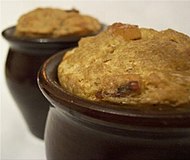 Belarusian potato babka
Belarusian potato babka
-
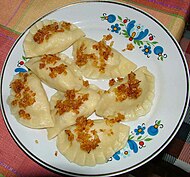 Polish pierogi
Polish pierogi
-
Romanian Sărmăluţe cu mămăligă
-
 Czech Vepřo-knedlo-zelo
Czech Vepřo-knedlo-zelo
-
Russian pirozhki
-
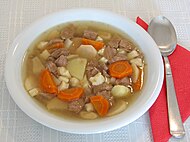 Hungarian gulyás
Hungarian gulyás
-
 Ukrainian borscht
Ukrainian borscht
Northern European cuisines
 British cuisine
British cuisine
 Danish cuisine
Danish cuisine Estonian cuisine
Estonian cuisine Finnish cuisine
Finnish cuisine Icelandic cuisine
Icelandic cuisine Irish cuisine
Irish cuisine Lappish cuisine
Lappish cuisine Latvian cuisine
Latvian cuisine Lithuanian cuisine
Lithuanian cuisine Norwegian cuisine
Norwegian cuisine Swedish cuisine
Swedish cuisine
-
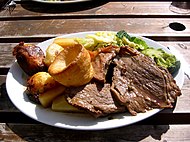 English Sunday roast
English Sunday roast
-
 Norwegian smørbrød
Norwegian smørbrød
-
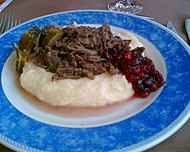 Finnish sautéed reindeer
Finnish sautéed reindeer
-
 Scottish haggis, neeps, and tatties
Scottish haggis, neeps, and tatties
-
 Irish stew
Irish stew
-
 Swedish meatballs
Swedish meatballs
-
 Lithuanian cold borscht
Lithuanian cold borscht
-
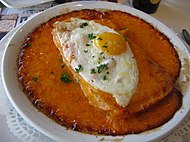 Welsh rarebit
Welsh rarebit
Southern European cuisines
Main article: Mediterranean cuisine Albanian cuisine
Albanian cuisine Bosnia and Herzegovina cuisine
Bosnia and Herzegovina cuisine Croatian cuisine
Croatian cuisine Cypriot cuisine
Cypriot cuisine Gibraltarian cuisine
Gibraltarian cuisine Greek cuisine
Greek cuisine
 Italian cuisine
Italian cuisine
 Macedonian cuisine
Macedonian cuisine Maltese cuisine
Maltese cuisine Montenegrin cuisine
Montenegrin cuisine Portuguese cuisine
Portuguese cuisine Serbian cuisine
Serbian cuisine Slovenian cuisine
Slovenian cuisine Spanish cuisine
Spanish cuisine
 Turkish cuisine
Turkish cuisine
-
Bosnian ćevapi
-
 Macedonian Tavče Gravče
Macedonian Tavče Gravče
-
Croatian žganci
-
Maltese octopus stew
-
Cypriot bamies
-
 Serbian Đuveč
Serbian Đuveč
-
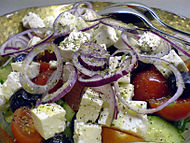 Greek salad
Greek salad
-
 Portuguese amêijoas à bulhão pato
Portuguese amêijoas à bulhão pato
-
Italian polenta with rabbit
-
Portuguese cozido
-
Italian risotto alla milanese
-
 Spanish paella
Spanish paella
-
 Italian spaghetti alla carbonara
Italian spaghetti alla carbonara
-
Spanish tapas
-
 Neapolitan pizza
Neapolitan pizza
-
 Turkish kebab
Turkish kebab
Western European cuisines
 Austrian cuisine
Austrian cuisine Belgian cuisine
Belgian cuisine Dutch cuisine
Dutch cuisine French cuisine
French cuisine
 German cuisine
German cuisine Liechtensteiner cuisine
Liechtensteiner cuisine Luxembourgian cuisine
Luxembourgian cuisine Swiss cuisine
Swiss cuisine
-
 Austrian schweinsbraten with semmelknödel
Austrian schweinsbraten with semmelknödel
-
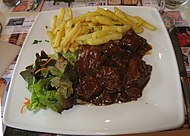 Belgian carbonnade flamande
Belgian carbonnade flamande
-
 Belgian moules frites
Belgian moules frites
-
 French magret
French magret
-
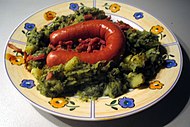 Dutch Boerenkoolstamppot with rookworst
Dutch Boerenkoolstamppot with rookworst
-
French fondue savoyarde
-
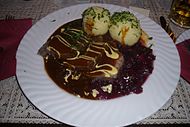 German Sauerbraten with potato dumplings
German Sauerbraten with potato dumplings
-
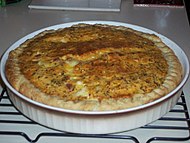 French quiche lorraine
French quiche lorraine
See also
References
- ^ "European Cuisine." Europeword.com. Accessed July 2011.
- Leung Man-tao (12 February 2007), "Eating and Cultural Stereotypes", Eat and Travel Weekly, no. 312, p. 76. Hong Kong
- Kwan Shuk-yan (1988). Selected Occidental Cookeries and Delicacies, p. 23. Hong Kong: Food Paradise Pub. Co.
- Lin Ch'ing (1977). First Steps to European Cooking, p. 5. Hong Kong: Wan Li Pub. Co.
- Kwan Shuk-yan, pg 26
Further reading
- Albala, Ken (2003). Food in Early Modern Europe. Greenwood Publishing Group. ISBN 0313319626. Retrieved November 2012.
{{cite book}}: Check date values in:|accessdate=(help); Cite has empty unknown parameter:|coauthors=(help) - R & R Publishing; ; et al. (2005). European Cuisine: The Best in European Food. Cpg Incorporated. ISBN 1740225279. Retrieved November 2012.
{{cite book}}: Check date values in:|accessdate=(help); Cite has empty unknown parameter:|coauthors=(help); Explicit use of et al. in:|last=(help)CS1 maint: multiple names: authors list (link)
| European cuisine | |||||
|---|---|---|---|---|---|
| Sovereign states |
| ||||
| States with limited recognition | |||||
| Dependencies and other territories | |||||